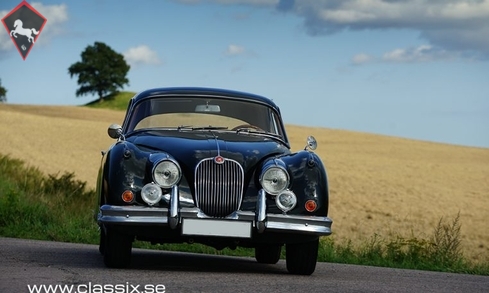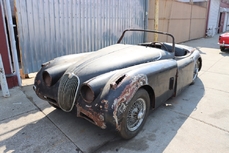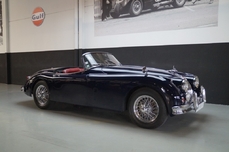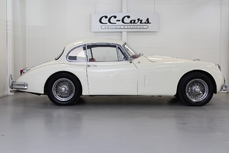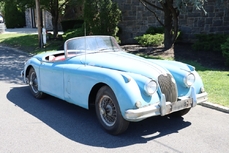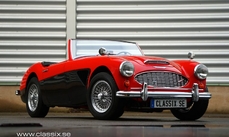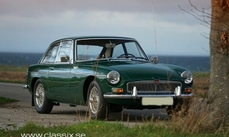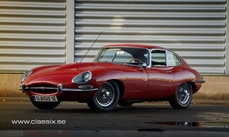Jaguar XK150 150 Coupe left hand drive 1958
General description :
Exterior: To me it is refreshing to see a Jaguar XK 150 Fixed Head Coupe with silver painted wire wheels. That are fitted with Wredestein Classic Tyres. The entire package with hubs, wheels and tyres are new. The paintwork from 2005 is still very good and there is no sign of any corrosion. Only some small traces of use can be found. Chrome is good and the bumpers are still the original showing small traces of age.
Interior: Wonderful brown leather and new carpets in the same tone. The leather quality is superior and the craftmanship is just beautiful. All the Jaguar instruments are in excellent condition. Updated steering but time period correct steering wheel that has a great feeling. Children can ride in the back of a Jaguar XK 150 and if you need to bring your fishing rod you open the little lid towards the trunk.
Engine: The Jaguar XK 150 FHC engine in this car starts very easy and feels very strong. Recent engine work is new pistons/rings. The crank was grinded and fitted with new bearings. The top was rebuild with new valves. New chain and tensioner. 123 ignition is fitted and it is possible to adjust the powerband curve. The radiator has just been rebuilt and a new water pump has been fitted.
The XK 150 FHC keeps cool with an electric fan that you can set when you want it to kick in. To make this classic car fit more in to todays driving condition a Getrag 5 speed gearbox and a new driveshaft has been fitted. And to make sure you will be able to stop when you are flying down the freeway some proper brake callipers have been fitted. The brake servo was just rebuilt and a new master cylinder fitted. For a nice exhaust note a new stainless steel exhaust has been fitted.
History: Like many of the left hand drive classic Jaguar cars we have in Sweden this car was first delivered to USA. It came to Sweden in 1993 and the present owner of the Jaguar XK 150 had it for 22 years. It has been properly maintained over the years and has covered just 1000 km since the last oil change and lubrication.
Also a Jaguar XK 120 for sale here
English Car Care will repair your Jaguar
Make:Jaguar
Model:XK 150 FHC
Km:10000
Transmission:5-Speed Manual
Manufactured in:U.K
Horsepower/kw:220
Condition:2
https://www.classix.se/classic-cars/jaguar-xk-150-coupe-2/
1958 Jaguar XK150 150 Coupe left hand drive is listed sold on ClassicDigest in Saxtorp by Auto Dealer for €75000.
Car Facts
Car type : Car Make : Jaguar Model : XK150 Model Version : 150 Coupe left hand drive Engine size : 0.0 Model Year : 1958 Sub type : Coupé Location : Saxtorp
Sold
Seller Information
Sold
People who viewed this Jaguar XK150 also viewed similar Jaguar listed at ClassicDigest
Other cars listed for sale by this dealer
About Jaguar
Ah, the story of Jaguar, from its early days as the SS Cars Ltd. to its pinnacle with the D-type, and the street-going evolution in the form of the iconic E-type. There's something quintessentially British about this tale, and I'll narrate it as a British journalist might.In the Beginnings:
Our journey into the world of Jaguar begins in the 1930s, when a company known as SS Cars Ltd. emerged. Despite the unfortunate coincidence of their initials with the rising political tensions in Europe, they started producing stylish and performance-oriented cars. The SS 100, introduced in 1936, was a symbol of elegance and speed, setting the stage for what would become Jaguar.
The Birth of Jaguar:
As the shadows of World War II loomed, SS Cars Ltd. wisely decided to disassociate themselves from the SS initials. Thus, in 1945, they officially became Jaguar Cars Ltd., a name that would soon be synonymous with British luxury and performance.
The XK Series:
Jaguar's post-war era brought us the XK 120, a true sensation in 1948. With its sleek design and a powerful 3.4-liter inline-six engine, it became the world's fastest production car. The XK 120 was the blueprint for what lay ahead – Jaguars that blended style with speed in a uniquely British fashion.
The D-type Dominance:
Then came the D-type, a true racing legend. Introduced in 1954, it won Le Mans three times in the 1950s, showcasing Jaguar's engineering prowess. With its innovative monocoque construction and the iconic fin at the back, the D-type was the apex of Jaguar's motorsport success.
The E-type Emergence:
But the true turning point arrived in 1961 with the introduction of the E-type, often described by Enzo Ferrari as "the most beautiful car ever made." Its long bonnet, curvaceous body, and a 3.8-liter engine delivering exhilarating performance made it an instant classic. The E-type was not just a car; it was a work of art on wheels, and it could hit 150 mph on the road.
Street and Racing Success:
The E-type's beauty was matched by its capability on the track. The lightweight E-types were particularly successful in various racing events, cementing Jaguar's reputation as a force to be reckoned with in motorsport.
The Age of Refinement:
As we delve deeper into the Jaguar story, we find that the 1950s and 1960s were an age of refinement and expansion. Alongside the magnificent D-type and the E-type's iconic emergence, Jaguar introduced models that further solidified its reputation for luxury and performance.
The MK2:
In the late 1950s, Jaguar unveiled the MK2, a sports sedan that combined elegance with power. This sleek four-door saloon was a favorite of bank robbers and law enforcement alike, thanks to its exceptional speed and handling. The MK2 was a symbol of Jaguar's ability to blend sophistication with performance and had a successful racing career as well.
The XJ6:
Fast forward to 1968, and Jaguar launched a car that would define luxury saloons for decades to come – the XJ6. It was a masterpiece of engineering and design, featuring a smooth inline-six engine, independent rear suspension, and a spacious, beautifully appointed interior. The XJ6 was a symbol of British elegance and provided a ride so smooth that it seemed to glide over the road. It became the flagship model for Jaguar and set the standard for luxury saloons, showcasing a level of refinement that left competitors in awe.
The Blend of Classic and Modern:
While the MK2 and XJ6 represented the evolution of Jaguar's saloon cars, they maintained the brand's commitment to performance and luxury. These cars didn't just belong on the racetrack; they were equally at home cruising down the grand boulevards or gliding through the English countryside.
The Challenges of Change:
However, as the 1970s arrived, Jaguar, like many British automakers, faced financial challenges and changes in ownership. The British Leyland era brought both opportunities and struggles, as the brand navigated through various mergers and transitions.
Nevertheless, the legacy of the MK2 and XJ6, along with the D-type and E-type, continues to define Jaguar as a manufacturer that combines timeless elegance with a spirit of performance. These classic models, whether driven on winding roads or parked as collectors' treasures, serve as a testament to Jaguar's enduring presence in the world of automotive excellence.
The Jaguar story, from its early days as SS Cars Ltd. to the creation of automotive icons like the E-type, MK2, and XJ6, is a journey that reflects the very essence of British motoring – a blend of luxury, power, and style that continues to captivate enthusiasts and connoisseurs alike.
